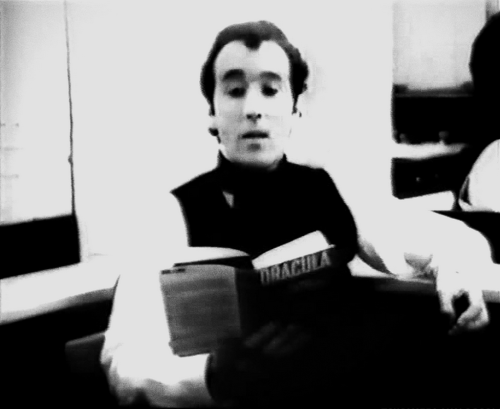 |
| (Vampire Cuadecuc/1971) |
You just have to let Pere Portabella’s Vampire Cuadecuc (1971) fog its way through you. The second half of the title refers to the tail end of a reel of film; the part where frames get bleached out. It’s an appropriate title, because it can feel at times like we’re watching stolen images from that forbidden end. Portabella overexposed some shots, blurred-out others, mashed together a sound mix that sounds like it comes from a basement (a basement with a sense of humor), and allowed his documentary on the making of the notoriously schlocky Jess Franco film Count Dracula (1970) to be a documentary only in the sense that it questions that very term. This oddity is more of a 67-minute element. You observe it for what feels like a while, then it’s gone.
The main players in Vampire Cuadecuc: Christopher Lee, the star of Count Dracula (1970); Maria Rohm, a Franco regular who plays Mina Harker, the much distressed love-interest in Bram Stoker’s story; Soledad Miranda, as Lucy, her friend with lesbian overtones/undertones; Herbert Lom as professor Van Helsing; and various cameramen, makeup artists and extras. These main players are seen mostly in footage from the actual film, but shot in black and white and from differing angles, making the film an interesting comparison piece to the actual narrative film on the most superficial level. But Portabella is not too concerned with making a comparison—or a companion—piece to the work of filmmaking it portrays. He is after something more self-conscious and nightmarish. As the credits state, the film is based on an ‘idea’ by Portabella and Joan Bossa. What that idea is, beyond the idea of documenting the making of a film, may be to create a horror-document, rather than a made-up scary story. The film is dotted with shots of Lee grabbing a swooning Rohm and biting in to her neck, followed by the camera operator circling in to the frame. It shows detached hands—never the bodies they belong to—dusting Lee’s face with makeup before he settles down in to his coffin to continue his ungodly vampire existence. As Dracula creeps around his large parlor, talking to a mystified Jonathan Harker, who has just arrived at his castle, the camera pans to lights in the background. But those are not lights of a film set. They are spidery technological enablers of a vampire. Those are not quite hands of paid artists on a film set either, or camera operators trying to tell a story. Indeed, the most peculiar implication of Vampire Cuadecuc is that all the main players—actors, technicians, objects, elements—by creating fictional evil are in fact enabling actual, abstract evil. This must have been Portabella’s overarching idea and his inquiry in to this weird game looks, literally, almost black.
 |
| (Vampire Cuadecuc/1971) |
It is because of the seemingly critical nature of Vampire Cuadecuc that some have read in to the film an allegory of Franco’s regime (the dictator, not the director, though the coincidence is amusing). But this interpretation is beside the point when we get down to the real meat of Portabella’s imagery. Practically speaking, he aimed to recap the story of Dracula via documentary filmmaking. This he did, but along the way he was boldly unafraid of experimentations with sound, with film stock, and with the apparently serious-minded nature of his project. Vampire Cuadecuc is not afraid of making a joke, or admitting that it’s all just a film after all. Near the end, we are treated to shots of the cast and crew gathering on a wide stage for what looks like either a break or a celebration, followed by Lee removing his fake mustache and his plastic eyeballs with a certain bemusement. The last scene is of Lee sitting in his dressing room, reading from the final pages of the original novel in a surprisingly mannered actor’s voice. That we realize this was all just a story being told is either a cop-out on Portabella’s part, or an admission he had to make to save his film from criticisms of pretentiousness. Whichever it is, his film is a dazzle; today, it is treated as both an obscure artifact and a provocative work of pseudo-non-fiction. It is concerned with the art of creation rather than the art of journalism or politics; it prefers wild images, at times for the sake of wildness, to the concept of sticking to the main theme. There is no main theme; there are only main rhythms, repetitions, objects, and faces. Vampire Cuadecuc is a document to be experienced; it fogs its way through you.
 |
| (Christopher Lee in Vampire Cuadecuc/1971) |